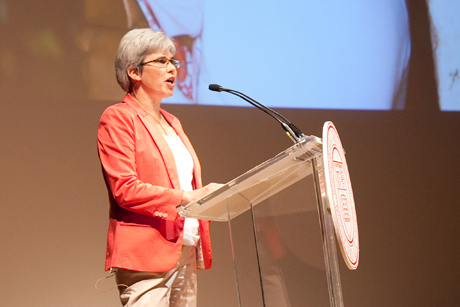'Big Red, Big Impact' engages Chicago audience
By Jose Perez Beduya

Adorned with bright, wall-sized images from campus and a faithful replica of the iconic Ezra Cornell statue, “Big Red, Big Impact” brought Cornell University to the Windy City Oct. 18. President David Skorton led the event, held at the Art Institute of Chicago, which capped off Cornell’s yearlong celebration of the Morrill Land Grant Act’s 150th anniversary. With faculty speakers, the evening also showcased the university’s far-reaching public engagement mission. Almost 300 alumni, parents and friends from the Chicago area attended.
Cornell trustee William Perez ’69 kicked off the program by acknowledging volunteers and donors in the region, including members of the 1865 Society, who have made gifts of any size to the university for at least two consecutive years.
“Thank you so much for giving so generously of your time and wisdom and for keeping the Cornell spirit alive. You have been equally generous with your philanthropic support of Cornell,” he said. Among these contributions, Perez highlighted the $190,000 in endowed scholarship funds raised to date by the Cornell Club of Chicago, providing 92 scholarships to 83 Chicago-area students.
Continuing the theme of expanded educational access and opportunity, Skorton touted the increased economic, geographic and cultural diversity of Cornell’s student body, and lauded Cornell’s new partnership with the Posse Foundation – an organization that will yearly bring to Cornell a multicultural cohort, or “posse,” of 10 students from Chicago schools, who will serve as a support system for each other on campus. Skorton also mentioned Cornell’s recent membership in Say Yes to Education Inc., a national nonprofit organization that helps disadvantaged urban youths attend college.
Skorton noted the role of recent philanthropic efforts to advance other strategic endeavors. These included the Next Generation Cassava Breeding project in Africa, supported by the Bill & Melinda Gates Foundation; Cornell Tech, boosted by a $350 million lead gift from Chuck Feeney ’56 and by a recent $133 million gift from Irwin Mark Jacobs ’54 and Joan Klein Jacobs ’54 to establish the Joan and Irwin Jacobs Technion-Cornell Innovation Institute, and provided transitional rent-free space by Google Inc.; and Klarman Hall, the soon-to-be-built humanities building, supported by a lead gift from Beth and Seth ’79 Klarman and funded entirely by donors.
Throughout the evening, faculty presentations demonstrated Cornell’s contemporary approach to public engagement: the university’s land-grant spirit applied to 21st-century realities. A hallmark of this approach involves mutually transformative partnerships with communities near and far, combined with strong collaboration among faculty, students and local counterparts.
Rebecca Stoltzfus, M.S. ’88, Ph.D. ’92, provost’s fellow for public engagement and director of Cornell’s programs in international nutrition and global health, introduced the audience to the new universitywide Engaged Learning + Research center. She also explained her work to address malnutrition in women and children in developing countries and shared her experience of learning in a local context by literally walking in the shoes of a village health worker in Zimbabwe.
Monroe Weber-Shirk, M.S. ’87, Ph.D. ’92, senior lecturer in civil and environmental engineering and founder and director of AguaClara at Cornell, discussed his team’s “journey inward and outward” through research on campus as well as on-the-ground partnerships with international nonprofit organizations to bring water treatment designs and technologies to remote rural communities overseas.
Natural sciences professor and director of the Civic Ecology Lab Marianne Krasny ’74 presented her work on civic ecology in Chicago and beyond. She discussed her collaborations with former graduate students in promoting community building and environmental stewardship practices to increase resiliency and well-being in cities in the U.S. and around the world.
A native of Rockland County, N.Y., and a former Cornell campus tour guide, Edwige Joseph ’12 was among many recent alumni at the event. Joseph, who lives in Chicago and works as 10th-grade chemistry teacher, said she was moved by nostalgia and pride for her alma mater.
“Cornell is asking not only how can we help communities locally and internationally but also how can we engage our students and give them meaningful experiences,” she said. “When they leave Cornell, these students, in turn, ask how can they make a difference in the communities around them. I think it’s really great that Cornell is giving them this opportunity.”
Jose Perez Beduya is a writer for Alumni Affairs and Development.
Media Contact
Get Cornell news delivered right to your inbox.
Subscribe